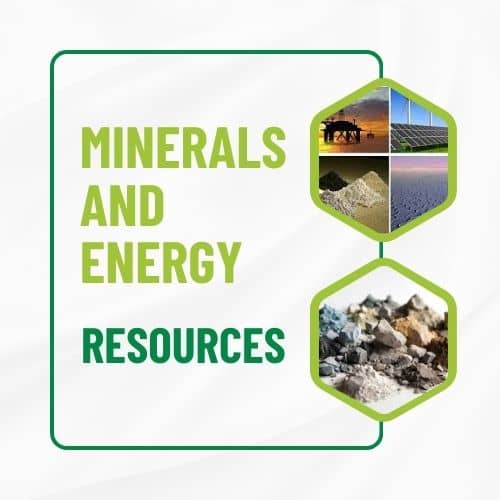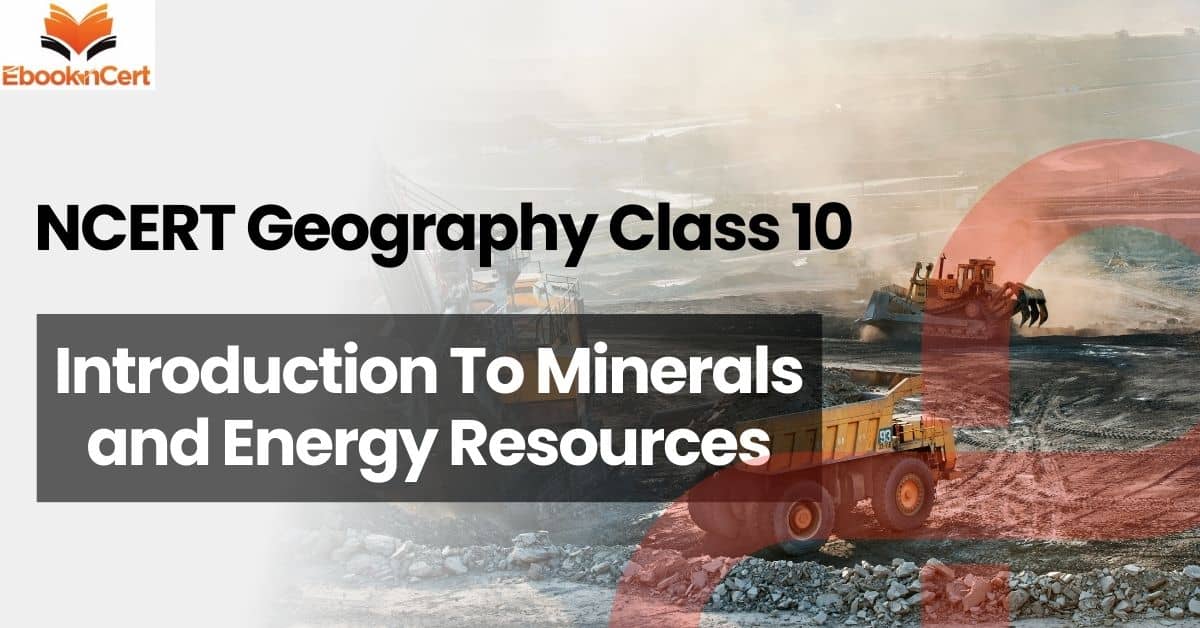NCERT Geography Class 10 | Introduction To Minerals and Energy Resources
Topic & sub-topics covered: Introduction to Minerals and Energy Resources and MCQs Questions: Minerals and Energy Resources (All single detail notes are exam-oriented).
We have discussed in-depth and exam-oriented pointers that can be asked in the board exam of class 10th about “Introduction to Minerals and Energy Resources” from the NCERT Geography notes for class 10th chapter 5th “Minerals and Energy Resources“.
Download the NCERT Geography for Class 10th Chapter 5 Minerals and Energy Resources PDF Notes
NCERT Geography Class 10th Chapter 5 – Minerals and Energy Resources
Complete your Geography preparation for your board exam or any examinations for NCERT Geography Class 10 Chapter 5: Minerals and Energy Resources PDF Notes! This chapter dives deep into the types, distribution, and uses of various minerals and energy resources, the Occurrence Of Minerals, and the Conservation Of Minerals that are essential for human development. With explanations that are easy to understand for any student and key points highlighted, these notes are ideal for exam preparation and quick revisions. Simplify your study process with this comprehensive resource. Download the PDF now and stay ahead in your Class 10 Geography journey!
Introduction To Minerals and Energy Resources

1. Introduction to Minerals/What is a mineral?:
- Minerals are homogeneous, naturally occurring substances with a definable internal structure.
- Found in varied forms:
a. Hardest: Diamond.
b. Softest: Talc. - Minerals are the building blocks of rocks, which can be single-mineral (e.g., limestone) or multi-mineral compositions.
2. Importance of Minerals:
- Daily Life Usage:
a. Minerals are essential for everything from a pin to a ship.
b. Used in construction (buildings, roads, railway tracks) and manufacturing (cars, buses, machinery).
c. Power sources like fuels are derived from the earth’s minerals. - Human Life Dependency:
a. Life processes depend on minerals; they enable the utilization of other nutrients.
b. Only 0.3% of nutrient intake comes from minerals critical for survival. - Cultural Significance: Minerals have been used historically for livelihood, decoration, ceremonies, and religious rites.
3. Properties of Minerals:
- Minerals differ due to physical and chemical conditions during formation.
- Properties used for classification:
a. Colour, hardness, crystal form, lustre, and density. - Minerals vary in abundance: Over 2000 minerals identified, but only a few are common in most rocks.
4. Geological Perspective:
- Formation of Minerals: A combination of elements forms specific minerals under certain conditions.
- Minerals in Rocks:
a. Rocks are combinations of minerals in varying proportions.
b. Example: Limestone contains a single mineral; others are multi-mineral.
5. Role of Geographers and Geologists:
- Geographers: Study minerals to understand landforms, distribution, and associated economic activities.
- Geologists: Focus on the formation, age, physical and chemical composition of minerals.
6. Applications and Daily Observations:
- Transportation Systems:
a. Buses, trains, and aeroplanes are made of minerals and run on mineral-derived fuels. - Toothpaste Ingredients:
a. Cleaning agents: Silica, limestone, aluminium oxide, phosphate minerals.
b. Fluoride: From fluorite to prevent cavities.
c. Whitening: Titanium oxide from rutile, ilmenite, anatase.
d. Sparkle: From mica. - Light Bulb: Investigate the variety of minerals involved in its creation.
- Plastics in Toothbrush: Derived from petroleum, showcasing the role of minerals in modern life.
7. Classification of Minerals:
- Minerals can be classified based on their geological formation, properties, and commercial uses.
8. Case Study from Text:
- Haban’s visit to Guwahati highlights the role of minerals in creating transportation systems (buses and trains made of iron, and aluminium).
- Minerals are indispensable in socio-economic activities, supporting daily life and industrial growth.
Next & Previous Topics of NCERT/CBSE Geography Class 10 Chapter 5: Minerals and Energy Resources
| Topics No. | Topics Name |
|---|---|
| 1 | Introduction To Minerals and Energy Resources |
| 2 | Mode of Occurrence of Minerals |
| 3 | Conservation of Minerals |
MCQ Questions on NCERT Geography Class 10 Chapter 5 | Introduction for Minerals and Energy Resources
Question 1. What is the main material used to make buses and trains?
A. Wood
B. Bricks
C. Iron and Aluminium
D. Plastic
Answer: C. Iron and Aluminium
Question 2. Which mineral is used in toothpaste to reduce cavities?
A. Silica
B. Fluorite
C. Rutile
D. Mica
Answer: B. Fluorite
Question 3. What gives sparkle to some toothpaste?
A. Titanium Oxide
B. Mica
C. Aluminium Oxide
D. Limestone
Answer: B. Mica
Question 4. From which material are toothbrushes made?
A. Plastic from petroleum
B. Metal from iron
C. Rubber from latex
D. Wood from trees
Answer: A. Plastic from petroleum
Question 5. What percentage of our total nutrient intake is represented by minerals?
A. 50%
B. 10%
C. 5%
D. 0.3%
Answer: D. 0.3%
Question 6. What defines a mineral according to geologists?
A. Heterogeneous, naturally occurring substance
B. Homogeneous, naturally occurring substance with a definable internal structure
C. A combination of metals
D. A synthetic compound
Answer: B. Homogeneous, naturally occurring substance with a definable internal structure
Question 7. Which of the following is the hardest mineral?
A. Talc
B. Quartz
C. Diamond
D. Feldspar
Answer: C. Diamond
Question 8. Which of the following is the softest mineral?
A. Quartz
B. Talc
C. Gypsum
D. Calcite
Answer: B. Talc
Question 9. What property is NOT used to classify minerals?
A. Colour
B. Hardness
C. Taste
D. Lustre
Answer: C. Taste
Question 10. Which of the following is an example of a single-mineral rock?
A. Granite
B. Limestone
C. Basalt
D. Sandstone
Answer: B. Limestone
Question 11. Which everyday object is made using abrasive minerals like silica and limestone?
A. Glass
B. Toothpaste
C. Plastic
D. Metal rods
Answer: B. Toothpaste
Question 12. What is the primary source material for the tarmac used in road construction?
A. Sand
B. Minerals
C. Cement
D. Asphalt
Answer: B. Minerals
Question 13. Which mineral is used to make light bulbs?
A. Tungsten
B. Quartz
C. Fluorite
D. Rutile
Answer: A. Tungsten
Question 14. What is the main use of titanium oxide in toothpaste?
A. Reducing cavities
B. Adding sparkle
C. Making it white
D. Strengthening enamel
Answer: C. Making it white
Question 15. What is a major interest of geographers in the study of minerals?
A. Formation of minerals
B. Distribution and economic activities associated with minerals
C. Chemical composition of minerals
D. Crystal forms of minerals
Answer: B. Distribution and economic activities associated with minerals
Question 16. Which mineral is commonly used in rituals and decorations?
A. Talc
B. Mica
C. Quartz
D. Diamond
Answer: D. Diamond
Question 17. Which rock is composed of several minerals in varying proportions?
A. Granite
B. Limestone
C. Coal
D. Salt
Answer: A. Granite
Question 18. What determines the type of mineral formed?
A. The type of rock it is embedded in
B. The physical and chemical conditions during formation
C. Its colour
D. The depth at which it is found
Answer: B. The physical and chemical conditions during formation
Question 19. What property of minerals results in their wide range of appearances?
A. Variation in soil types
B. Chemical composition and formation conditions
C. Age of the mineral
D. Exposure to sunlight
Answer: B. Chemical composition and formation conditions
Question 20. Which profession primarily focuses on the formation and age of minerals?
A. Geographer
B. Geologist
C. Mineralogist
D. Environmentalist
Answer: B. Geologist

